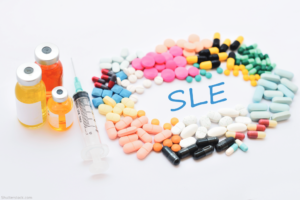 PHILADELPHIA—On Saturday, Nov. 12, at ACR Convergence 2022, Joan T. Merrill, MD, director of clinical projects in the Arthritis & Clinical Immunology Program at the Oklahoma Medical Research Foundation in Oklahoma City, gave a presentation on the future of drug development and treatments for systemic lupus erythematosus (SLE). She described how an in-depth understanding of specific subsets of patients with lupus, and of specific drug effects and interactions, can lead to better treatments for patients.
PHILADELPHIA—On Saturday, Nov. 12, at ACR Convergence 2022, Joan T. Merrill, MD, director of clinical projects in the Arthritis & Clinical Immunology Program at the Oklahoma Medical Research Foundation in Oklahoma City, gave a presentation on the future of drug development and treatments for systemic lupus erythematosus (SLE). She described how an in-depth understanding of specific subsets of patients with lupus, and of specific drug effects and interactions, can lead to better treatments for patients.
Pathophysiology & Heterogeneity
Dr. Merrill began by touching on the complex pathophysiology of SLE, which involves both an initial innate immune response, including the production of interferons and other cytokines, and a later adaptive immune response, in which the stimulation of B cells is central. Dr. Merrill commented on the many different cellular pathways and interacting proteins involved in this pathophysiology. She also noted how variants in many different genes may play a role in perpetuating these disease activation pathways.
“We know this is not a single-gene disease,” she said.
Dr. Merrill described the unpredictable, complex, heterogeneous nature of the clinical manifestations of SLE, which can vary in the organ systems affected and in disease severity. The disease is also heterogeneous on a molecular level, with different groups of genes and their respective proteins upregulated or downregulated in certain subsets of lupus patients, creating another level of complexity.
Through machine-based learning approaches, Dr. Merrill’s colleagues at the Oklahoma Medical Research Foundation, Joel M. Guthridge, PhD, and Judith A. James, MD, PhD, have identified seven different clusters of lupus patients based on molecular and immunological profiles, distinct from clinical features, such as arthritis or nephritis.1 Dr. Merrill pointed out that patients can move from cluster to cluster depending on their disease activity, their medications and other factors. Thus, she believes lupus should still be considered a single disease entity, although a multifaceted one.
Challenges of Lupus Drug Development
This disease’s fluidity and heterogeneity are part of what has made drug development for lupus so challenging. If only subsets of lupus patients are likely to respond to a given therapy because of differences in disease pathophysiology, background treatment and other factors, the overall effectiveness rates in lupus trials will be lower, even if a treatment could be very effective for specific subsets of lupus patients.
“Between 2003 and 2011, 30 different intellectually promising drugs went into development for lupus, and 29 of them failed,” Dr. Merrill said. The U.S. Food & Drug Administration (FDA) did approve belimumab in 2011, making it the first drug approved for lupus in more than 50 years.
Dr. Merrill noted the belimumab trial was very large, upping the statistical power. This helped the researchers get statistically significant findings, even if the treatment response rates were only a little higher than the placebo responses when all lupus patients were considered as a group and not by disease subsets.
Impact of Polypharmacy
Dr. Merrill explained that polypharmacy is another factor that can make it challenging to get positive results in lupus trials. She pointed out that patients come to lupus trials on a variety of background immunosuppressants, but these can impact the response to the studied treatment. For example, whether a patient is on background methotrexate or azathioprine impacts the expression of different lupus genes, altering their immune profiles. This may affect response to a trial agent.
To address the issue of polypharmacy, Dr. Merrill described her biomarkers of lupus disease (BOLD) study, which used an immunosuppressant withdrawal strategy.2 “You take away all background medications, except maybe minimal amounts of steroid or hydroxychloroquine, and you look at time to flare,” she said. When patients flare, they are treated immediately and recorded as non-responders. Executed correctly and by excluding patients with organ-threatening disease, such studies can be done safely, explained Dr. Merrill.
Dr. Merrill also argued that we need to make progress in understanding how older drugs, such as hydroxychloroquine, work at the genomic and molecular levels, to know how they may best be combined with additional drugs in specific patient subsets. “To figure out how drugs work, … we have to separate them out from all the other drugs, study them in a cleaner environment and then figure out which [lupus patient] subset we need to look at, to see if the drug made an impact,” she said. “It’s tough work, but it’s not impossible.”
Immunologic Parameters
Interferon signals have provided an initial approach to addressing immune heterogeneity and finding subsets of patients that may best respond to certain treatments. Dr. Merrill discussed anifrolumab, a monoclonal antibody that inhibits type I interferon signaling. Although patients with increased interferon signals showed a greater difference between treatment and placebo groups, this seemed to be due to a relatively lower placebo response and not an improved response to treatment. Dr. Merrill showed data to suggest that the four-gene signature the anifrolumab development team used to define interferon signals may not be optimal as a diagnostic.3
Dr. Merrill also described analyses from a phase 2 trial of obexelimab, an agonist of the Fc receptor γRIIb, which helps dampen signals going through the B cell receptor. Although the study did not meet its primary end point of percent of patients without flare at day 225, it met a secondary end point of time to flare. Moreover, when Dr. Merrill and colleagues analyzed the results by the same lupus clusters that had previously been described in Oklahoma, they found that drug responsiveness seemed to occur almost exclusively in patients in two of the seven lupus clusters, resulting in nominally statistically significant improvement.4,5
These clusters shared key characteristics of low inflammation, high B cell and plasma cell pathway signals and signals relating to rapid cell cycle rates. “If you look at people with high inflammation, this drug does not work,” said Dr. Merrill, “But if you look at patients with low inflammation, you get a big difference from the placebo group.”
Moving Forward
Dr. Merrill noted that trials as large as belimumab’s usually aren’t possible, and we need to find ways to design studies that can demonstrate effectiveness with smaller patient numbers. “We are better at clinical data accuracy than we were 10 years ago; we are better at trial design; we know how to get end points that are a little more discriminatory than what we were using in the past, and we’ve been reducing polypharmacy,” she said. “But we also need to reduce immune heterogeneity and select the patients that are most likely to respond to a drug.”
Dr. Merrill concluded that we can carefully construct clinical trials and analyze results to “improve the feasibility of unraveling complex pharmacodynamic interactions at many levels, from the gene to environmentally-induced activation states.”
Dr. Merrill is planning to use these strategies in her upcoming trial of mycophenolate mofetil alone or with voclosporin in patients with lupus, sponsored by the National Institutes of Health. Dr. Merrill and colleagues will also study gene expression patterns at baseline and/or in response to mycophenolate mofetil alone or along with voclosporin, to get a better idea of the immunologic changes involved in treatment response and treatment failure.
Ruth Jessen Hickman, MD, is a graduate of the Indiana University School of Medicine. She is a freelance medical and science writer living in Bloomington, Ind.
References
- Guthridge JM, Lu R, Tran LTH, et al. Adults with systemic lupus exhibit distinct molecular phenotypes in a cross-sectional study. EClinicalMedicine. 2020 Mar 4;20:100291.
- Merrill JT, Immermann F, Whitley M, et al. The biomarkers of lupus disease study: A bold approach may mitigate interference of background immunosuppressants in clinical trials. Arthritis Rheumatol. 2017 Jun;69(6):1257–1266.
- Morand EF, Furie R, Tanaka Y, et al. Trial of anifrolumab in active systemic lupus erythematosus. N Engl J Med. 2020 Jan 16;382(3):211–221.
- Merrill JT, June J, Koumpouras F, et al. Top-line results of a phase 2, double-blind, randomized placebo-controlled study of a reversible B cell inhibitor, XmAb5871 in systemic lupus erythematosus (SLE) [abstract]. Arthritis Rheumatol. 2018;70(suppl 9).
- Merrill JT, Guthridge J, Zack D, et al. Discrimination of systemic lupus (SLE) patients with clinical response to obexelimab (XmAb5871) based on a pattern of immunologic markers [abstract SAT0187]. Ann Rheum Dis. 2020;79(suppl 1).

